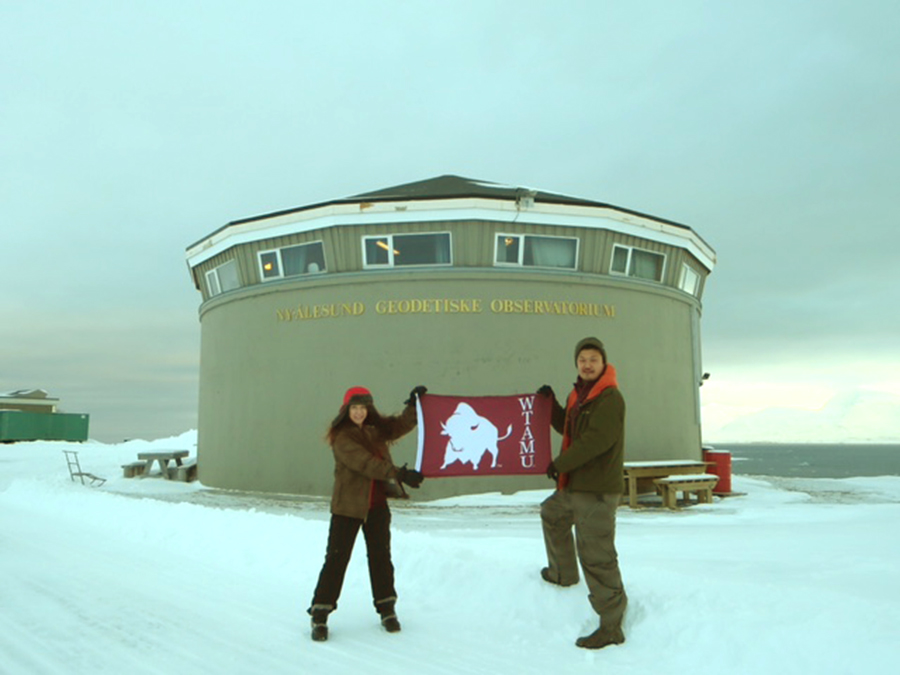"It could easily be said that Dr. Naruki Hiranuma has his head is in the clouds. Literally. It’s a good thing, too, because the West Texas A&M University professor has traveled as far as the Arctic to gather aerosol samples—fine solid or liquid particles suspended in the air— for extensive research on cloud formation and composition in his Atmospheric and Aerosol Measurement Lab at the University’s Killgore Research Center.
Hiranuma, an assistant professor of environmental science at WTAMU, has an extensive background in the study of aerosol-cloud interactions. He earned his master’s degree in 2005 at WTAMU and returned in 2016 as a faculty member with a Ph.D. and plenty of working experience with internationally renowned scientists around the globe to share his expertise in climate science in the classroom and the research lab. He also brought with him a collaboration with ArCS—Arctic Challenge For Sustainability—a five-year, eight-scientific theme project funded by the Japan Ministry of Education, Culture, Sports, Science and Technology to study the changes and impact of aerosols in cloud, precipitation and climate.
That collaboration took Hiranuma and graduate student Maria Pantazi to the project’s study site in Ny-Alesund, Svalbard in March. As a collaborator, Hiranuma is working on Theme 3 of the project, titled Atmospheric Climate Forcers in the Arctic. He and Pantazi braved the frigid temperatures and frequent snowstorms to gather airborne particle samples at a mountain top station as well as ground-based observatories. The site is the perfect location to collect samples, often in clouds, because air currents transport aerosols—natural and manmade—from around the world to the Arctic. The samples give researchers like Hiranuma the opportunity to study how aerosols like black carbon affect the Arctic atmosphere, where the temperature is warming faster than anywhere else on the planet.
“Clouds are very important for the global climate projection,” Hiranuma said. “Not all people know why clouds are there, what they are made of and what they are going to do. There is a lot of microphysics and chemistry involved in understanding what happens in a cloud.”
The Arctic aerosol samples are now in Hiranuma’s lab, where he measures and analyzes the particles with instruments developed by graduate student, Craig Whiteside through a National Institute of Polar Research (NIPR) travel fellowship to learn about atmospheric ice nucleation simulation chambers. The research looks specifically at ice nucleating particles and how they interact with water vapor and/or super-cooled water droplets in the atmosphere.
“The analysis tells us what the clouds are made of and shows what size, how it looks and its composition elements,” Hiranuma said. “The particles—millions of them—are very small, but they have a major impact in research. Knowing the composition of the particles enables us to make artificial clouds in the lab.”
And that is what Hiranuma and his graduate students are doing. In addition to testing the Arctic aerosol samples, Hiranuma also is testing aerosol samples from the Texas Panhandle. He and Whiteside have collected several samples from the area, including feedlots and coal-burning smokestacks. These samples, just like the Arctic samples, are being analyzed for composition to see what conditions are needed to make ice in the clouds. Conditions are replicated in the lab’s cloud simulation chamber for further study. The feedlot samples, unique to West Texas, contain agricultural aerosols composed of feed, fibers and dust. Hiranuma is looking at how these unique aerosols affect ice formation in clouds and potentially cause hailstorms in the Texas Panhandle.
“My goal in the research is actually to do hail predictions—better hail predictions—and in the future, hail prevention,” he said. “If you know, then you can prepare. To do this, we have to understand the chemistry and the physics of hail formation.”
His research offers plenty of hands-on experience for students as well. Whiteside, who received the NIPR travel fellowship, helped Hiranuma build a replica of an ice nucleation chamber in the Killgore Lab. Another graduate student, Kimberly Cory, is currently in Japan through a National Science Foundation fellowship to conduct collaborative research on ice nucleation biological fibers and proteins. More projects and opportunities are available, and Hiranuma is excited to share his climate science expertise with a growing student enrollment.
“Dr. Hiranuma diversifies and advances the WTAMU research portfolio with his study of aerosol cloud interactions,” Dr. Angela Spaulding, vice president for research and compliance and dean of Graduate School, said. “He is an exceptional researcher, student mentor and scientific collaborator—on the WTAMU campus and worldwide.”
Hiranuma said his Arctic research in Ny-Alesund was a cloud scientist’s dream come true, but he’s on cloud nine right here in the Texas Panhandle with teaching and research at WTAMU."

-WTAMU-
